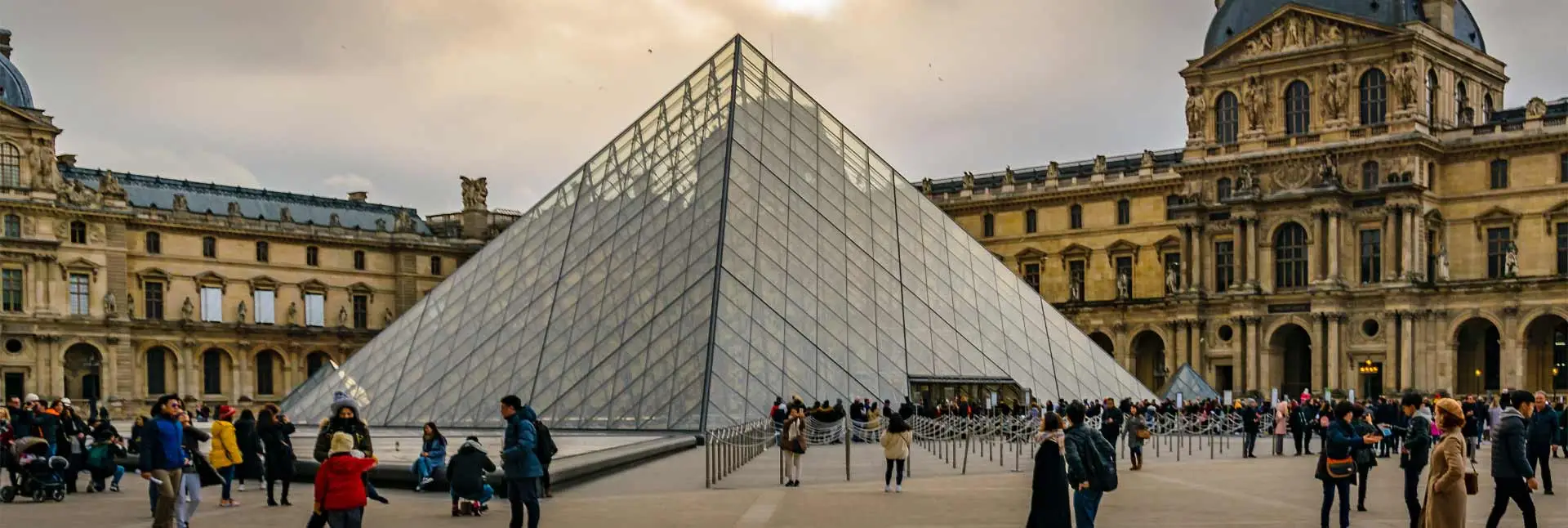
Learn about the history of the Louvre Museum
The Louvre Museum is much more than an art gallery; it is a living testament to centuries of history, culture, and architectural evolution. From its origins as a medieval fortress to becoming the most visited museum in the world, the Louvre has witnessed some of the most important events in the history of France and universal art.
Musée du Louvre: History from medieval fortress to royal residence
The origins of the Louvre date back to the 12th century, when King Philip II Augustus ordered the construction of a fortress on the right bank of the Seine to protect Paris from potential invasions. This structure, with towers and defensive walls, became one of the kingdom's main strongholds.
Over time, the Louvre evolved from being a simple fortress to a royal residence under the reign of Charles V. In the 16th century, Francis I, a passionate admirer of Renaissance art, marked a turning point by ordering the demolition of the medieval fortifications to build a Renaissance-style palace.
Additionally, Francis I acquired one of the Louvre’s most iconic pieces: Leonardo da Vinci’s Mona Lisa. This transformation laid the foundation for the Louvre to become a space that gathered the best of art and architecture from each era.
The transformation of the Louvre into a museum: a gift of the French Revolution
The Louvre Museum, as we know it today, opened its doors in 1793, during the height of the French Revolution. The National Assembly decided to transform the former royal palace into a public space dedicated to art and knowledge. With an initial collection composed of works confiscated from the Church and the nobility, the museum quickly became a globally significant cultural center.
Between the 19th and 20th centuries, the Louvre's collection grew exponentially thanks to Napoleon Bonaparte’s campaigns, during which he acquired treasures from Egypt, Greece, and Rome. Although some of these artifacts were returned after his fall, many pieces, such as the Winged Victory of Samothrace and the Venus de Milo, remained in the Louvre, solidifying its status as a global reference museum.
The architecture of the Louvre: the story of a dialog between eras
The architecture of the Louvre is a living testament to France’s historical transformations, reflecting the political, cultural, and artistic changes that have shaped the country. Its origins date back to the medieval period when it was a defensive fortress, but under the reign of Henry IV and Louis XIII, it adopted a Renaissance style. With the addition of the Richelieu and Sully pavilions, the complex gained its characteristic square courtyard, establishing itself as an emblem of the era's art.
Later, during the reign of Louis XIV, known as the "Sun King," architect Claude Perrault added the majestic Colonnade of the Louvre, a classical-style façade that gave the building a monumental elegance. This architectural detail reflected the grand and orderly spirit of French absolutism.
In the 20th century, the Louvre underwent a modern transformation with the addition of the iconic glass pyramid designed by Ieoh Ming Pei in 1989. This contemporary structure, which serves as the museum's main entrance, was initially controversial but has since become a symbol of the union between historical tradition and architectural innovation. Each stage in the Louvre’s evolution has left a unique mark, making its architecture a true dialogue between eras.
Historical moments in the Louvre Museum in Paris
The Louvre has not only been an art museum but also a silent witness to moments that have shaped history and global culture. During the Napoleonic Wars, the museum became a repository for treasures looted by Napoleon in his military campaigns, establishing itself as the epicenter of European art at the time.
Later, during the dark years of World War II, many of its masterpieces were carefully hidden to prevent confiscation by the Nazis. Thanks to these efforts, invaluable treasures such as the Mona Lisa were preserved.
In more recent times, the Louvre has expanded its global cultural impact, particularly in the 21st century, with the opening of international branches such as the Louvre Abu Dhabi, reaffirming its role as a universal symbol of art and history.
Visit the Louvre and be part of history
The Louvre Museum is not just a place to admire masterpieces such as the Mona Lisa, Delacroix’s Liberty Leading the People, or Michelangelo’s Slaves. It is also a space where history, architecture, and art blend uniquely. If you are planning to visit Paris, we invite you to book your tickets to the Louvre Museum and discover this iconic museum with us. We offer personalized tours that will allow you to uncover its secrets, understand its history, and appreciate its art in a truly unique way.